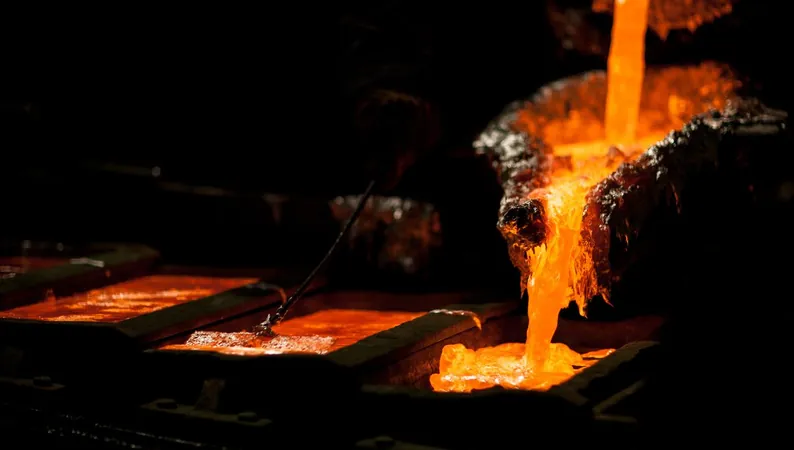
Could This Ancient Discovery Change Our Understanding of Early Metallurgy?
2025-04-02
Author: Ken Lee
Exploring the Origins of Metallurgy
The origins of metallurgy remain shrouded in mystery, with experts pondering the circumstances that sparked this revolutionary technology. While some theories suggest metallurgy emerged alongside pottery, due to the shared need for specialized furnaces, established examples of copper metallurgy are traced back to Belovode and Pločnik in Serbia, dating from 5350 to 4600 BCE.
The Gre Filla Discovery
However, a groundbreaking discovery in 2021 at a site known as Gre Filla in the Upper Tigris valley could rewrite this narrative. Here, researchers unearthed a peculiar, vitrified lump within an area considered to be an ancient street, situated in sediment that has been dated to nearly 11,000 years ago—making it significantly older than any previously confirmed metallurgical findings.
Intriguing Findings
The analysis revealed some intriguing findings: nearby, an abundance of ash and charcoal was detected alongside various animal bones, suggesting that this area might frequently have been the site of cooking fires. This raises the tantalizing possibility that copper present in the soil could have inadvertently melted. However, further investigation points to a more sophisticated scenario than mere accidental melting.
Evidence of High Temperatures
The researchers found "high-temperature mineral phases" indicating exposure to extreme heat, approximately 1,000 °C (1,830 °F). Additionally, distinct "microstructural features" point towards rapid cooling after heating, implying a more controlled environment than a rudimentary cooking fire.
Depression Marks
Notably, “depression marks” on one side of the lump suggest that it may have been in contact with the inner surface of a furnace or kiln. This compelling evidence supports the notion that this object experienced high temperatures in a deliberate setting. Yet, despite these promising findings, researchers faced challenges as no actual furnace was discovered in close proximity to the vitrified piece. To date, only a single dome-shaped furnace has been located at Gre Filla, though its function remains a mystery.
Challenges in Interpretation
Crucially, the absence of metallurgical by-products such as slag further complicates claims of intentional smelting at this site. The presence of such residues would have strengthened the case for advanced metallurgical practices among these ancient Anatolian hunter-gatherers, yet their lack tempers the study authors’ conclusions.
Conclusions and Future Research
Despite the limitations, the researchers assert: “Although there is no direct evidence of full-scale metal smelting, the presence and distribution of copper droplets imply that copper-bearing material or native copper was exposed to high heat.” They advocate for a reevaluation of Gre Filla, suggesting that it may not be a fully developed site of metallurgy, but rather an exploratory location where the foundations of metallurgical techniques—such as controlled heating, casting, and potential ore-processing—were being actively researched.
Implications for Understanding Early Technology
This discovery not only offers a glimpse into the early technological innovations of our ancestors, but also raises compelling questions about how metallurgy might have emerged in humanity’s prehistoric past. Could our understanding of ancient technology shift dramatically with further findings from sites like Gre Filla? Only time will tell, but as archaeologists continue to probe our shared history, the story of metallurgy may be far older and more complex than we ever imagined.




 Brasil (PT)
Brasil (PT)
 Canada (EN)
Canada (EN)
 Chile (ES)
Chile (ES)
 Česko (CS)
Česko (CS)
 대한민국 (KO)
대한민국 (KO)
 España (ES)
España (ES)
 France (FR)
France (FR)
 Hong Kong (EN)
Hong Kong (EN)
 Italia (IT)
Italia (IT)
 日本 (JA)
日本 (JA)
 Magyarország (HU)
Magyarország (HU)
 Norge (NO)
Norge (NO)
 Polska (PL)
Polska (PL)
 Schweiz (DE)
Schweiz (DE)
 Singapore (EN)
Singapore (EN)
 Sverige (SV)
Sverige (SV)
 Suomi (FI)
Suomi (FI)
 Türkiye (TR)
Türkiye (TR)
 الإمارات العربية المتحدة (AR)
الإمارات العربية المتحدة (AR)